I’ve got the power: How tower cranes became the latest battleground for alternative fuels
25 April 2023
As contractors come under more and more pressure to reduce carbon emissions, alternative solutions for powering tower cranes are becoming big business. Lucy Barnard assesses the options.
Standing high above the south Rotterdam skyline, it’s easy to spot the giant yellow Liebherr 630 EC-H 40 Litronic tower crane hard at work building the city’s new Simeon & Anna residential care centre next to the existing hospital.
Far harder to spot is the white metal box, roughly the size of a vending machine, inconspicuously located near the foot of the crane and silently providing the lion’s share of its power.
The box, rented from Dutch tower cranes specialist Van Der Spek and supplied by Belgium-based tower crane power solutions company Neargrid Solutions, contains a ‘boost’ battery, which contractor De Vries en Verburg Bouw has plugged into the crane instead of using a diesel generator.
“As you can see, our battery system runs silently and emits no fumes which is very important, especially for sites in built up city centres or near healthcare facilities,” says Bart Meersman, director and co-founder of Neargrid Solutions. “Diesel generators emit carbon dioxide and cause noise and odour pollution to the yard and its surroundings.”
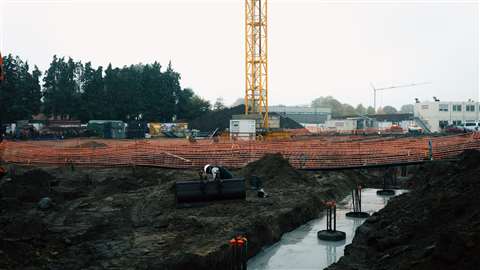 A Neargrid unit at the foot of a tower crane. Photo: Neargrid Solutions
A Neargrid unit at the foot of a tower crane. Photo: Neargrid Solutions
As contractors come under more and more pressure to reduce carbon emissions, alternative solutions for powering tower cranes are becoming big business. Boxes containing the batteries, fuel cells and mechanical devices needed to drive the tower cranes working on building sites are becoming more common around the world.
Most modern tower cranes have been manufactured to run on electricity since the 1970s. And yet, their high power demand often makes it difficult for contractors to connect them directly to the national grid, even if there is a connection available.
Meersman, an academic specializing in electrical engineering, points out that tower cranes require short bursts of high power for lifting loads on site combined with long periods of medium energy required the rest of the time they are working on site.
He and his team had initially been searching for a way to help cities tackle the energy transition when he started spotting diesel gensets being used on Belgian construction sites.
“Diesel generators have a very poor efficiency when supplying energy to tower cranes,” he says. “They require frequent maintenance as well as a regular supply of diesel which requires organisation and attention from construction site managers. These tasks can be avoided when using a battery system.
“We had already looked at diesel gensets when we were talking to the cities and seen that they were not being optimally used,” says Meersman. “Then we started seeing them on so many construction sites. We started off by performing a measurement campaign. We found that the energy they needed could be easily supplied by a low voltage grid connection but that the power needed to come from elsewhere.”
Instead, Meersman and his team devised a solution where the peak power needed by tower cranes can be provided by a battery system while the other power needs of the crane can be either supplied by a low-power grid connection, or if this is unavailable, a smaller diesel genset.
Lead acid battery system
Unlike some of its competitors, Neargrid’s battery solution uses traditional lead acid batteries to provide up to 200 kVA which the company says, is enough to power three tower cranes on most European building sites.
Meersman says that although that means his solutions don’t provide as much power as other alternatives such as Lithium-ion batteries or hydrogen fuel cells, the use of more established technology means costs are lower. As such, the company is able to sell its battery units for between €100,000 and €170,000 (US$110,000 and $187,000).
“From the research we conducted in Belgium, we saw that the energy needed could easily be supplied by the grid,” Meersman says. “Therefore we needed a battery technology with high peak power capacity but without the need for high energy capacity. These conditions brought us to lead acid batteries which are a proven technology and can easily be used in harsh environments which construction sites typically are. From both an economic and a technical point of view, lead acid batteries offer a viable solution.”
So far, Neargrid says it has been doubling sales each year, albeit from a small base, selling to rental companies, including Vandaele Rental in Belgium, Van Der Spek in the Netherlands and Eiffage Benelux subsidiary Sodemat.
And, with technology in the field rapidly evolving, Meersman says Neargrid must also investigate new products, including lithium-ion batteries or adding solar panels as an energy source.
One of Neargrid’s main competitors in terms of powering tower cranes is Ampd Energy, a Hong Kong-based company, founded in 2014. It started out making lithium-ion battery-powered backup power supplies for hospitals and data centres.
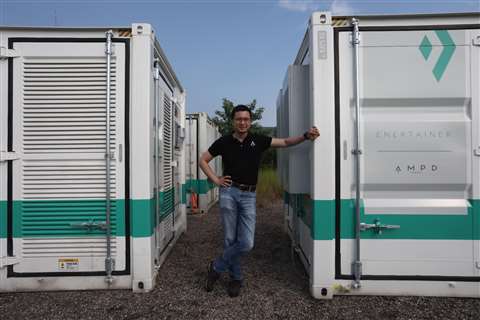 AMPD Energy’s CEO Brandon Ng with an AMPD Enertainer at Tseung Kwan O Industrial Estate. Photo: SCMP via Reuters Connect/ Jonathan Wong
AMPD Energy’s CEO Brandon Ng with an AMPD Enertainer at Tseung Kwan O Industrial Estate. Photo: SCMP via Reuters Connect/ Jonathan Wong
In 2019 it started marketing its products for the construction industry, producing a 2.6 metre square energy container box which the company branded ‘Enertainer’ and which contains 30,000 lithium-ion battery cells.
The company has supplied units to Hong Kong-based contractors Gammon Construction and Socam Development, Singaporean developer Far East Organization, and Australian construction company Multiplex.
In January 2023 UK-based Laing O’Rourke became the first European contractor to announce its use of an Enertainer unit to power three cranes at its London Olympia redevelopment site through its plant hire subsidiary Select.
“The Ampd Enertainer is a game changer for site electrics and its infrastructure,” says Ian Fleming, select site services product leader at Olympia. “Not only does it enable us to power the crane on a small grid connection, but the design allows us to feed it with small power cables and charge it when site demand for power is low. It has the capacity to run additional equipment so we are looking at other applications for it already.”
Ampd declined to say how much individual Enertainer units were selling for but pointed out that it had supplied more than 130 Enertainer boxes to construction sites around the world.
Hydrogen fuel cells
But battery storage solutions are not the only alternative energy sources being developed to power tower cranes.
Based on 19th Century underlying technology and used by NASA to power spacecraft in the 1960s, a number of start-ups are producing hydrogen fuel cell electricity generators as an alternative way of powering construction sites.
French provider EODev (Energy Observer Developments) is one of them.
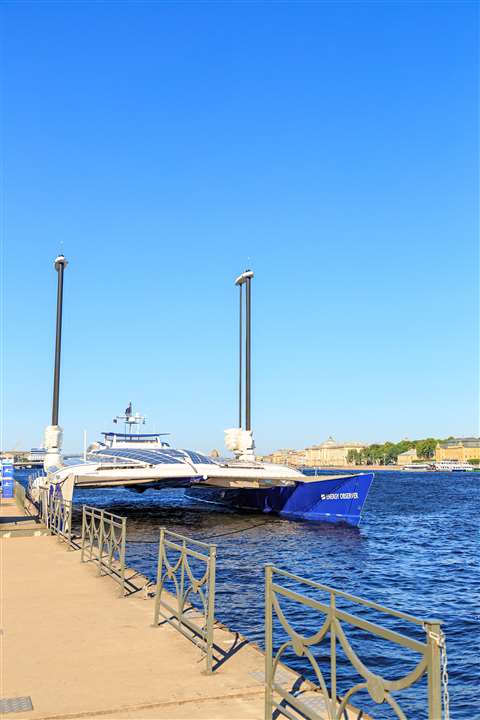 Energy Observer moored in St Petersberg. Photo: Adobe Stock/ Nikita Maykov
Energy Observer moored in St Petersberg. Photo: Adobe Stock/ Nikita Maykov
A company spun out of the Energy Observer project – an ambitious plan by round the world yachtsman Victorien Erussard, to create the world’s first boat to be powered by self-generated hydrogen, EODev has developed its GEH2 hydrogen power generator, a 3-metre wide and 2 metre high white metal box equipped with a single Toyota proton exchange membrane (PEM) fuel cell, capable of producing 100 kVA of electrical power, which it is marketing heavily, both at contractors and plant hire companies.
The company has already sold around 100 units around the world which includes orders from France-based Loxam, Australia-based Kennards Hire and Netherlands-based Genpower. In October 2022, United Rentals, the world’s largest equipment rental company announced it was adding several units to its fleet.
“Demand is rapidly increasing, supported by a growing availability of renewable hydrogen, public policies and a global willingness to accelerate the energy transition,” chief marketing officer, Thibault Tallieu told International Cranes and Specialized Transport.
Although EODev declined to give exact costs regarding its units, Tallieu says the capex for each unit stood at around four times that of a recently manufactured diesel genset. “You have to look at the total cost of ownership,” he says.
“There is a lower cost of maintenance because there are no moving parts and also fuel price trends are in favour of hydrogen.”
He adds that the units could be used on “all construction sites, from city centres to remote areas, so long as they are connected to a hydrogen storage.”
“The most obvious benefit with the GEH2 is that it creates no greenhouse gas emissions like carbon dioxide, no air pollutants like fine particles or nitrogen oxide and low noise,” he says. “The efficiency of fuel cell technology is about twice that of hydrogen combustion technology which also does not offer quiet operations and zero emissions on site as it still produces oxides of nitrogen and fine particles.”
Yet other companies are investing heavily in using hydrogen in the place of diesel to power cranes and other machinery.
UK-headquartered temporary power specialist Aggreko has been working with Belgian headquartered CMB.Tech to develop a 100 per cent hydrogen genset. In June 2021 the pair undertook a pilot project of a 50 kVA hydrogen combustion power generation unit at its depot in Moerdijk, Netherlands. It has built up a small fleet of generators which it is continuing to test with customers.
The machines work by combusting pressurised hydrogen gas in an internal combustion engine to drive an alternator to generate the electrical power then delivered to the site. Each hydrogen genset can generate up to 50 kVA, not itself enough to provide the full energy needs for a tower crane but enough to be used in conjunction with another power source such as a battery.
Hydrogen combustion gensets
“We have a number of units available for hire for our customers who are looking at their options for greener solutions as part of their future strategies,” says Carsten Reincke-Collon, director of future technologies at Aggreko. “It may not be for every customer, given the higher costs at present, but for those who are looking to explore lower emissions solutions, we are on hand to support.”
Reincke-Collon adds that, unlike hydrogen fuel cells which can be sensitive to freezing weather, hydrogen gensets like these can be used in colder climates.
He points out, however, that the current uncompetitive costs of hydrogen gas and the difficulties involved in both procuring and storing it are preventing the company from rolling out this solution at scale.
“The infancy of the hydrogen economy, the lack of mass scale hydrogen production and delivery means that it costs more than gas, diesel or biofuel equivalents,” he says. “The key challenges are tied to the cost, availability of hydrogen from low-carbon sources, and the poor volumetric energy density of hydrogen which limits the practicality of using hydrogen as a direct fuel for larger energy requirements in temporary power.”
Another innovative way in which contractors are attempting to help power tower cranes is not through alternative fuels at all but instead by using mechanics first developed hundreds of years ago, to balance out their electrical demands.
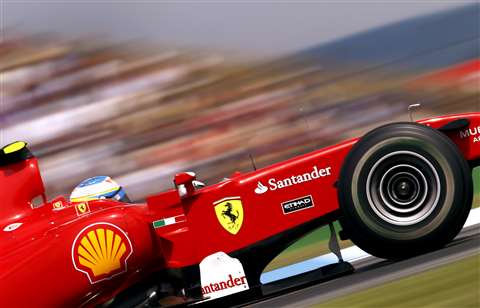 Ferrari Formula One driver Fernando Alonso of Spain steers his car to win the German Grand Prix at the Hockenheim circuit in July 2010. It was after a meeting of the governing International Automobile Federation (FIA) in Monaco ruled that from 2013, engines would be reduced from 2.4 litre V8s to four-cylinder 1.6-litre turbocharged units with a rev limit of 12,000 min-1 and linked to hybrid kinetic energy recovery systems (KERS). Photo: REUTERS/Kai Pfaffenbach
Ferrari Formula One driver Fernando Alonso of Spain steers his car to win the German Grand Prix at the Hockenheim circuit in July 2010. It was after a meeting of the governing International Automobile Federation (FIA) in Monaco ruled that from 2013, engines would be reduced from 2.4 litre V8s to four-cylinder 1.6-litre turbocharged units with a rev limit of 12,000 min-1 and linked to hybrid kinetic energy recovery systems (KERS). Photo: REUTERS/Kai Pfaffenbach
UK-based engineering company Punch Flybrid uses a flywheel to store up surplus energy produced by an electric generator during a crane’s low load periods. The flywheel stores it as kinetic energy which can then be quickly released to support the generator when the crane requires maximum power to lift heavy loads.
The company was founded in 2007 as a boutique engineering company specialising in developing ‘flybrid’ Formula One racing cars in response to a demand for these top motorsport teams to become more energy efficient.
In a similar way to hybrid road cars using a combination of a combustion engine and a battery, these racing cars replace the battery with a flywheel. It is spun up using kinetic energy recovered during braking, storing the energy which can then be released to provide an extra burst of speed.
Flywheels have been used for thousands of years in potters’ wheels and are fundamental to a large amount of 19th Century engineering. The Flybrid, however, includes some 21st Century innovation; it had the capacity to spin at more than 60,000 min-1. That means the outside of the wheel was travelling at close to the speed of sound. It is housed in a vacuum chamber to reduce air friction and avoid sonic booms.
Unfortunately for Punch Flybrid, its main market suddenly disappeared. After developing the first kinetic energy recovery system (KERS) for Formula One and working on the first hybrid racing car to complete the Le Mans 24 hour race, a change to F1 engine rules in 2014 meant its main market dried up overnight.
Instead, the company has diversified its offering, producing applications for trucks and busses, ships, port equipment, forestry and construction machinery.
“In motor racing a teams’ quest for higher performance spurs the search for greater efficiency – essentially doing more with less,” says Tobias Knichel, Punch Flybrid managing director. “We developed our flywheel technology to improve performance and efficiency at the very pinnacle of the automotive industry but its fundamentals mean there are opportunities to deploy its benefits in other sectors.”
In January 2021 the company launched its Punch Power 200 unit, a 350 mm diameter flywheel in a vacuum chamber and encased in a white box which takes up about as much space as a large kitchen fridge.
“Often on a construction site there is no connection to the national grid, so cranes are powered by generator sets,” Knichel says. “When they lift heavy loads there is a big power spike and our system injects energy at high power to cover these power spikes. As a result, the size of the generator can be reduced by a factor of three and we have recorded fuel savings of more than 50 %.”
Punch Flybrid says that not only is the device able to reduce carbon emissions at construction sites, they are easily recyclable and can be manufactured easily.
The company has signed deals with UK plant hire companies Sunbelt, Select and generator specialists Stuart Energy and Abird.
Flywheels
In 2021 Punch Flybrid announced a technical collaboration with Select Group to integrate flywheel energy storage directly into its tower cranes.
In 2022 the company collaborated with Technogen, part of Italian genset specialist Bruno Group, to develop a genset unit combining a hydrogen engine with flywheel power system technology. It was purchased by UK construction, engineering and rental business John F Hunt Power.
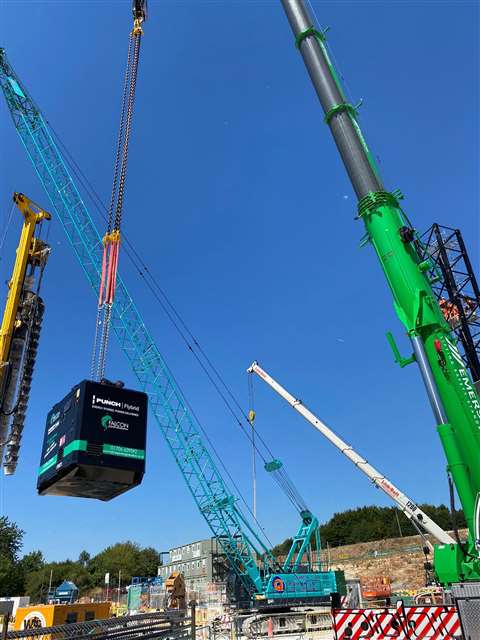 Falcon Group installs a Punch Flybrid unit at the HS2 site in Little Missenden, United Kingdom, in August 2022. Photo: Falcon Group
Falcon Group installs a Punch Flybrid unit at the HS2 site in Little Missenden, United Kingdom, in August 2022. Photo: Falcon Group
In August 2022 UK-based Falcon Cranes added several Punch Flybrid units to its power generation fleet and that a first unit had been put to work on the HS2 rail project in Little Missenden in Buckinghamshire.
Falcon calculated that the UK government’s decision to remove the rebate on (red) diesel for off-road construction machinery, coupled with recent fuel cost increases, at least cancelled out the cost of hiring the unit but, depending on the power demands of the application, could save the customer money as well as cutting carbon emissions by between 50 and 60 %.
Andrew Teanby, Falcon Power general manager, said, “We all strive to reduce our carbon footprint, it is now more important than ever. The trade off has always been, the more money you spend the more CO2 you can save – not anymore. With a Punch Flybrid system, we are proving to our customers that there is a significant, real term, cost saving to this system, while reducing their CO2 emissions by over half.”
Back in Belgium, Bart Meersman points out that, even though contractors are starting to see more and more alternative fuels becoming available to use on site, their ultimate energy needs are only likely to intensify.
“When we started out in 2020, the competitor product was a diesel genset, but the market has moved very quickly and now we are just as likely to be competing with another battery unit,” Meersman says. “In the meantime, more alternative battery solutions have become available which is good because competition creates a healthy market for our customers.”
“I think in the future, energy providers will become more of a central partner in construction sites, ensuring that the energy balance is covered and contractors can supply all the power that they need,” he adds. “If you have an excavator running on batteries that can last for four hours, then you need to ensure that those batteries are charged during your lunchbreak so work can continue. As more and more equipment begins to need charging, their needs will compete, so electrical supply on a construction site will become more important.







